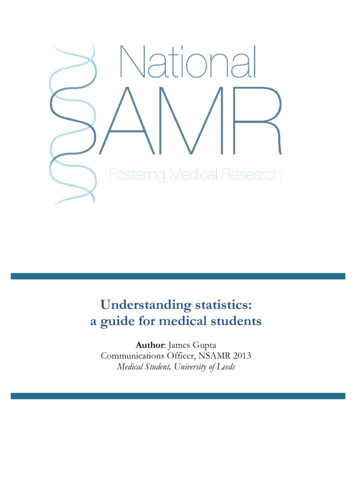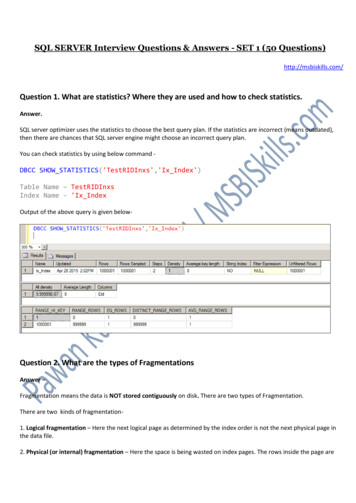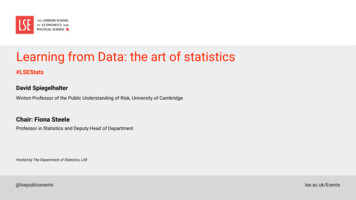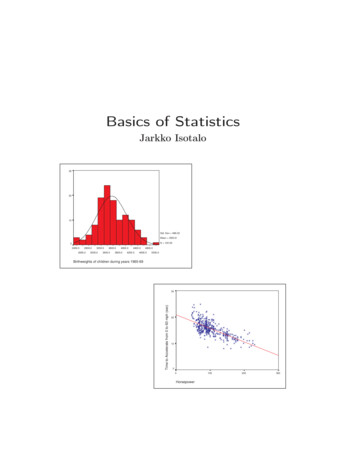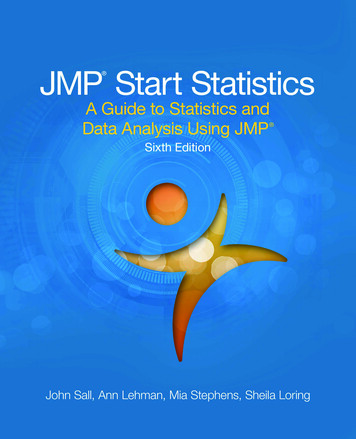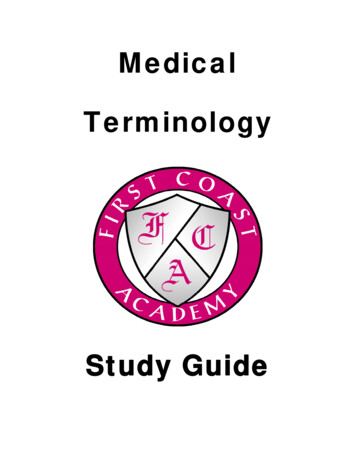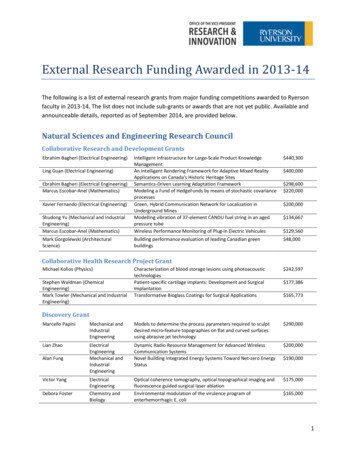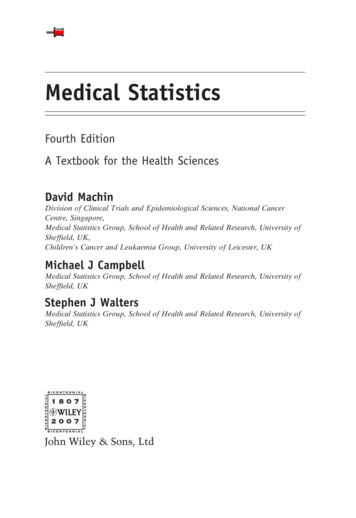
Transcription
Medical StatisticsFourth EditionA Textbook for the Health SciencesDavid MachinDivision of Clinical Trials and Epidemiological Sciences, National CancerCentre, Singapore,Medical Statistics Group, School of Health and Related Research, University ofSheffield, UK,Children’s Cancer and Leukaemia Group, University of Leicester, UKMichael J CampbellMedical Statistics Group, School of Health and Related Research, University ofSheffield, UKStephen J WaltersMedical Statistics Group, School of Health and Related Research, University ofSheffield, UK
This page intentionally left blank
Medical StatisticsFourth Edition
This page intentionally left blank
Medical StatisticsFourth EditionA Textbook for the Health SciencesDavid MachinDivision of Clinical Trials and Epidemiological Sciences, National CancerCentre, Singapore,Medical Statistics Group, School of Health and Related Research, University ofSheffield, UK,Children’s Cancer and Leukaemia Group, University of Leicester, UKMichael J CampbellMedical Statistics Group, School of Health and Related Research, University ofSheffield, UKStephen J WaltersMedical Statistics Group, School of Health and Related Research, University ofSheffield, UK
Copyright 2007John Wiley & Sons Ltd, The Atrium, Southern Gate, Chichester,West Sussex PO19 8SQ, EnglandTelephone ( 44) 1243 779777Email (for orders and customer service enquiries): cs-books@wiley.co.ukVisit our Home Page on www.wileyeurope.com or www.wiley.comAll Rights Reserved. No part of this publication may be reproduced, stored in a retrieval systemor transmitted in any form or by any means, electronic, mechanical, photocopying, recording,scanning or otherwise, except under the terms of the Copyright, Designs and Patents Act 1988 orunder the terms of a licence issued by the Copyright Licensing Agency Ltd, 90 Tottenham CourtRoad, London W1T 4LP, UK, without the permission in writing of the Publisher. Requests to thePublisher should be addressed to the Permissions Department, John Wiley & Sons Ltd, TheAtrium, Southern Gate, Chichester, West Sussex PO19 8SQ, England, or emailed to permreq@wiley.co.uk, or faxed to ( 44) 1243 770620.Designations used by companies to distinguish their products are often claimed as trademarks. Allbrand names and product names used in this book are trade names, service marks, trademarks orregistered trademarks of their respective owners. The Publisher is not associated with any productor vendor mentioned in this book.This publication is designed to provide accurate and authoritative information in regard to thesubject matter covered. It is sold on the understanding that the Publisher is not engaged inrendering professional services. If professional advice or other expert assistance is required, theservices of a competent professional should be sought.Other Wiley Editorial OfficesJohn Wiley & Sons Inc., 111 River Street, Hoboken, NJ 07030, USAJossey-Bass, 989 Market Street, San Francisco, CA 94103-1741, USAWiley-VCH Verlag GmbH, Boschstr. 12, D-69469 Weinheim, GermanyJohn Wiley & Sons Australia Ltd, 33 Park Road, Milton, Queensland 4064, AustraliaJohn Wiley & Sons (Asia) Pte Ltd, 2 Clementi Loop #02-01, Jin Xing Distripark, Singapore129809John Wiley & Sons Canada Ltd, 6045 Freemont Blvd, Mississauga, Ontario, L5R 4J3, CanadaWiley also publishes its books in a variety of electronic formats. Some content that appears inprint may not be available in electronic books.Anniversary Logo Design: Richard J. PacificoLibrary of Congress Cataloging-in-Publication DataCampbell, Michael J., PhD.Medical statistics : a textbook for the health sciences / Michael J.Campbell, David Machin, Stephen J. Walters. – 4th ed.p. ; cm.Includes bibliographical references.ISBN 978-0-470-02519-2 (cloth : alk. paper)1. Medical statistics. 2. Medicine–Research–Statistical methods. I. Machin, David,1939– II. Walters, Stephen John. III. Title.[DNLM: 1. Biometry–methods. 2. Research Design. 3. Statistics. WA 950 C189m 2007]R853.S7C36 2007610.72′7–dc22British Library Cataloguing in Publication DataA catalogue record for this book is available from the British LibraryISBN 978-0-470-02519-2Typeset in 10.5/12.5 Times by SNP Best-set Typesetter Ltd., Hong KongPrinted and bound in Great Britain by Antony Rowe Ltd,. Chippenham, WiltsThis book is printed on acid-free paper responsibly manufactured from sustainable forestry inwhich at least two trees are planted for each one used for paper production.
3.33.43.53.6Preface to the Fourth EditionxiUses and abuses of medical statistics1IntroductionWhy use statistics?Statistics is about common sense and good designTypes of dataHow a statistician can helpFurther readingExercisesDescribing and displaying categorical dataSummarising categorical dataDisplaying categorical dataPoints when reading the literatureExercisesDescribing and displaying quantitative dataSummarising continuous dataDisplaying continuous daaWithin-subject variabilityPresentationPoints when reading the 43
57.67.77.87.97.10CONTENTSProbability and decision makingTypes of probabilityDiagnostic testsBayes’ TheoremRelative (receiver)–operating characteristic (ROC) curvePoints when reading the literatureExercisesDistributionsIntroductionThe Binomial distributionThe Poisson distributionProbability for continuous outcomesThe Normal distributionReference rangesPoints when reading the literatureTechnical detailsExercisesPopulations, samples, standard errors and confidenceintervalsPopulationsSamplesThe standard errorThe Central Limit TheoremStandard errors for proportions and ratesStandard errors of differencesConfidence intervals for an estimateConfidence intervals for differencesPoints when reading the literatureTechnical detailsExercisesp-values and statistical inferenceIntroductionThe null hypothesisThe p-valueStatistical inferenceStatistical powerConfidence intervals rather than p-valuesOne-sided and two-sided testsPoints when reading the literatureTechnical 114114
.71111.111.211.3Tests for comparing two groups of categorical orcontinuous dataIntroductionComparison of two groups of paired observations –continuous outcomesComparison of two independent groups –continuous outcomesComparison of two independent groups –categorical outcomesComparison of two groups of paired observations –categorical outcomesNon-Normal distributionsDegrees of freedomPoints when reading the literatureTechnical detailsExercisesCorrelation and linear regressionIntroductionCorrelationLinear regressionComparison of assumptions between correlation andregressionMultiple regressionLogistic regressionCorrelation is not causationPoints when reading the literatureTechnical detailsExercisesSurvival analysisTime to event dataKaplan–Meier survival curveThe logrank testThe hazard ratioModelling time to event dataPoints when reading the literatureExercisesReliability and method comparison 4175175179181182185189190193197198201202203206
614.714.814.914.10CONTENTSValidityMethod comparison studiesPoints when reading the literatureTechnical detailsExercisesObservational studies209210212213215217IntroductionRisk and ratesTaking a random sampleQuestionnaire and form designCross-sectional surveysNon-randomised studiesCohort studiesCase–control studiesAssociation and causalityPoints when reading the literatureTechnical 39The randomised controlled trial241IntroductionWhy randomise?Methods of randomisationDesign featuresDesign optionsMeta-analysisThe protocolChecklists for design, analysis and reportingNumber needed to treat (NNT)Points when reading the literatureExercisesSample size issuesIntroductionStudy sizeContinuous dataBinary dataPrevalenceSubject withdrawalsInternal pilot studiesPoints when reading the literatureTechnical 61262263267268270271272272273274
CONTENTS1515.115.215.315.415.515.615.715.8Common pitfallsIntroductionUsing the t-testPlotting change against initial valueRepeated measuresClinical and statistical significanceExploratory data analysisPoints when reading the ferences291Solutions to exercises297Statistical he Normal distributionRandom numbersStudent’s t-distributionThe χ2 distributionNormal ordinates for cumulative probabilities316318319320321322
This page intentionally left blank
Preface to the Fourth EditionRevised editions of books are often only minor departures from previouseditions. In this edition, however, with the aid of a new co-author we haveattempted a total revamp of our previously successful textbook. We did thisbecause not only have twenty years passed but the statistical requirementsof medical journals are now more rigorous and there has been an increasingdemand for the newer statistical methods to meet new scientific challenges.Despite this, we have retained the popular approach of explaining medicalstatistics with as little technical detail as possible, so as to make the textbookaccessible to a wide audience. In general, we have placed the, sometimesunavoidable, more technical aspects at the end of each chapter. We haveupdated many of the examples to give a more modern approach, but haveretained a few classics from the earlier editions, because they so well illustratethe point we wish to make.To aid the individual learner, exercises are included at the end of eachchapter, with answers provided at the end of the book. We have concentratedthe design issues into three chapters, concerning the design of observationalstudies, randomised clinical trials and sample size issues. Many health scientists will have to validate their methods of measurement, and a new featurein this book is a chapter on reliability and validity.Students of the health sciences, such as medicine, nursing, dentistry, physiotherapy, occupational therapy, and radiography should find the book useful,with examples relevant to their disciplines. The aim of training courses inmedical statistics pertinent to these areas is not to turn the students intomedical statisticians but rather to help them interpret the published scientificliterature and appreciate how to design studies and analyse data arising fromtheir own projects.We envisage the book being useful in two areas. First, for consumers ofstatistics who need to be able to read the research literature in the field with
xiiPREFACE TO THE FOURTH EDITIONa critical eye. All health science professionals need to be able to do this, butfor many this is all they will need. We suggest that Chapters 1–7 would formthe basis of a course for this purpose. However, some (perhaps trainee) professionals will go on to design studies and analyse data from projects, and so,secondly, the book will be useful to doers of statistics, who need relativelystraightforward methods that they can be confident of using. Chapters 8–15are aimed at this audience, though clearly they also need to be familiar withthe earlier chapters. These students will be doing statistics on computer packages, so we have given ‘generic’ output which is typical of the major packages,to aid in the interpretation of the results.We thank Lucy Sayer from Wiley for her patience, for what initially wassimply a revision, but is now essentially a new textbook.David MachinSingapore and Sheffield and Leicester, UKMichael J CampbellSheffield, UKStephen J WaltersSheffield, UKNovember 2006
1Uses and abuses ofmedical statistics1.1 Introduction1.2 Why use statistics?1.3 Statistics is about common sense and good design1.4 Types of data1.5 How a statistician can help1.6 Further reading1.7 ExercisesMedical Statistics Fourth Edition, David Machin, Michael J Campbell, Stephen J Walters 2007 John Wiley & Sons, Ltd234591112
2USES AND ABUSES OF MEDICAL STATISTICSSummaryStatistical analysis features in the majority of papers published in health carejournals. Most health care practitioners will need a basic understanding ofstatistical principles, but not necessarily full details of statistical techniques.Medical statistics can contribute to good research by improving the designof studies as well as suggesting the optimum analysis of the results. Medicalstatisticians should be consulted early in the planning of a study. They cancontribute in a variety of ways at all stages and not just at the final analysisof the data once the data have been collected.1.1IntroductionMost health care practitioners do not carry out medical research. However,if they pride themselves on being up to date then they will definitely be consumers of medical research. It is incumbent on them to be able to discerngood studies from bad; to be able to verify whether the conclusions of a studyare valid and to understand the limitations of such studies. Evidence-basedmedicine (EBM) or more comprehensively evidence-based health care(EHBC) requires that health care practitioners consider critically all evidence about whether a treatment works. As Machin and Campbell (2005)point out, this requires the systematic assembly of all available evidence followed by a critical appraisal of this evidence.A particular example might be a paper describing the results of a clinicaltrial of a new drug. A physician might read this report to try to decidewhether to use the drug on his or her own patients. Since physicians areresponsible for the care of their patients, it is their own responsibility toensure the validity of the report, and its possible generalisation to particularpatients. Usually, in the reputable medical press, the reader is to some extentprotected from grossly misleading papers by a review process involving bothspecialist clinical and statistical referees. However, often there is no suchprotection in the general press or in much of the promotional literaturesponsored by self-interested parties. Even in the medical literature, misleading results can get through the refereeing net and no journal offers a guarantee as to the validity of its papers.The use of statistical methods pervades the medical literature. In a surveyof original articles published in three UK journals of general practice; BritishMedical Journal (General Practice Section), British Journal of General Practice and Family Practice; over a 1-year period, Rigby et al (2004) found that66% used some form of statistical analysis. It appears, therefore, that themajority of papers published in these journals require some statistical knowledge for a complete understanding.
1.2 WHY USE STATISTICS?3Statistics is not only a discipline in its own right but it is also a fundamentaltool for investigation in all biological and medical science. As such, anyserious investigator in these fields must have a grasp of the basic principles.With modern computer facilities there is little need for familiarity with thetechnical details of statistical calculations. However, a health care professional should understand when such calculations are valid, when they are notand how they should be interpreted.1.2Why use statistics?To students schooled in the ‘hard’ sciences of physics and chemistry itmay be difficult to appreciate the variability of biological data. If one repeatedly puts blue litmus paper into acid solutions it turns red 100% of thetime, not most (say 95%) of the time. In contrast, if one gives aspirin toa group of people with headaches, not all of them will experience relief.Penicillin was perhaps one of the few ‘miracle’ cures where the resultswere so dramatic that little evaluation was required. Absolute certainty inmedicine is rare.Measurements on human subjects rarely give exactly the same results fromone occasion to the next. For example, O’ Sullivan et al (1999), found thatsystolic blood pressure in normal healthy children has a wide range, with 95%of children having systolic blood pressures below 130 mmHg when they wereresting, rising to 160 mmHg during the school day, and falling to below130 mmHg at night.This variability is also inherent in responses to biological hazards. Mostpeople now accept that cigarette smoking causes lung cancer and heartdisease, and yet nearly everyone can point to an apparently healthy 80-yearold who has smoked for 60 years without apparent ill effect.Although it is now known from the report of Doll et al (2004) that abouthalf of all persistent cigarette smokers are killed by their habit, it is usuallyforgotten that until the 1950s, the cause of the rise in lung cancer deaths wasa mystery and commonly associated with diesel fumes. It was not until thecarefully designed and statistically analysed case–control and cohort studiesof Richard Doll and Austin Bradford Hill and others, that smoking wasidentified as the true cause. Enstrom and Kabat (2003) have now moved thedebate on to whether or not passive smoking causes lung cancer. This is amore difficult question to answer since the association is weaker.With such variability, it follows that in any comparison made in a medicalcontext, differences are almost bound to occur. These differences may be dueto real effects, random variation or both. It is the job of the analyst to decidehow much variation should be ascribed to chance, so that any remainingvariation can be assumed to be due to a real effect. This is the art ofstatistics.
4USES AND ABUSES OF MEDICAL STATISTICS1.3Statistics is about common sense and good designA well-designed study, poorly analysed, can be rescued by a reanalysis but apoorly designed study is beyond the redemption of even sophisticated statistical manipulation. Many experimenters consult the medical statistician onlyat the end of the study when the data have been collected. They believe thatthe job of the statistician is simply to analyse the data, and with powerfulcomputers available, even complex studies with many variables can be easilyprocessed. However, analysis is only part of a statistician’s job, and calculation of the final ‘p-value’ a minor one at that!A far more important task for the medical statistician is to ensure thatresults are comparable and generalisable.Example from the literature: Fluoridated water suppliesA classic example is the debate as to whether fluorine in the water supplyis related to cancer mortality. Burke and Yiamouyannis (1975) considered10 fluoridated and 10 non-fluoridated towns in the USA. In the fluoridatedtowns, the cancer mortality rate had increased by 20% between 1950 and1970, whereas in the non-fluoridated towns the increase was only 10%.From this they concluded that fluoridisation caused cancer. However,Oldham and Newell (1977), in a careful analysis of the changes in age–gender–ethnic structure of the 20 cities between 1950 and 1970, showedthat in fact the excess cancer rate in the fluoridated cities increased byonly 1% over the 20 years, while in the unfluoridated cities the increasewas 4%. They concluded from this that there was no evidence that fluoridisation caused cancer. No statistical significance testing was deemed necessary by these authors, both medical statisticians, even though the paperappeared in a statistical journal!In the above example age, gender and ethnicity are examples of confounding variables as illustrated in Figure 1.1. In this example, the types of individuals exposed to fluoridation depend on their age, gender and ethnic mix,and these same factors are also known to influence cancer mortality rates. Itwas established that over the 20 years of the study, fluoridated towns weremore likely to be ones where young, white people moved away and these arethe people with lower cancer mortality, and so they left behind a higher riskpopulation.Any observational study that compares populations distinguished by aparticular variable (such as a comparison of smokers and non-smokers) andascribes the differences found in other variables (such as lung cancer rates)to the first variable is open to the charge that the observed differences are infact due to some other, confounding, variables. Thus, the difference in lung
1.4 TYPES OF DATAEXPOSUREOUTCOMEFluoridisationCancer mortality5Confounding Factor(s)Age, gender, ethnicityFigure 1.1 Graphical representation of how confounding variables may influence bothexposure to fluoridisation and cancer mortalitycancer rates between smokers and non-smokers has been ascribed to geneticfactors; that is, some factor that makes people want to smoke also makesthem more susceptible to lung cancer. The difficulty with observationalstudies is that there is an infinite source of confounding variables. An investigator can measure all the variables that seem reasonable to him but a criticcan always think of another, unmeasured, variable that just might explain theresult. It is only in prospective randomised studies that this logical difficultyis avoided. In randomised studies, where exposure variables (such as alternative treatments) are assigned purely by a chance mechanism, it can be assumedthat unmeasured confounding variables are comparable, on average, in thetwo groups. Unfortunately, in many circumstances it is not possible to randomise the exposure variable as part of the experimental design, as in thecase of smoking and lung cancer, and so alternative interpretations are alwayspossible. Observational studies are further discussed in Chapter 12.1.4Types of dataJust as a farmer gathers and processes a crop, a statistician gathers and processes data. For this reason the logo for the UK Royal Statistical Society isa sheaf of wheat. Like any farmer who knows instinctively the differencebetween oats, barley and wheat, a statistician becomes an expert at discerningdifferent types of data. Some sections of this book refer to different datatypes and so we start by considering these distinctions. Figure 1.2 shows abasic summary of data types, although some data do not fit neatly into thesecategories.Example from the literature: Risk factors for endometrial cancerTable 1.1 gives a typical table reporting baseline characteristics of a set ofpatients entered into a case–control study which investigated risk factorsfor endometrial cancer (Xu et al, 2004). We will discuss the different typesof data given in this paper.
6USES AND ABUSES OF MEDICAL ominalOrdinalCountsCategoriesare mutuallyexclusive andunorderedCategoriesare mutuallyexclusive andorderedIntegervaluesExamples:gender,blood group,eye colour,marital statusExamples:diseasestage,social class,educationlevelExamples:days sick peryear,number ofpregnanciesFigure 1.2QuantitativeMeasured(continuous)Takes anyvalue in arange ofvaluesExamples:weight in kg,height in mage (in years,hours,minutes )Broad classification of the different types of data with examplesCategorical or qualitative dataNominal categorical data Nominal or categorical data are data that onecan name and put into categories. They are not measured but simplycounted. They often consist of unordered ‘either–or’ type observationswhich have two categories and are often know as binary. For example:Dead or Alive; Male or Female; Cured or Not Cured; Pregnant or NotPregnant. In Table 1.1 having a first-degree relative with cancer, or takingregular exercise are binary variables. However, categorical data oftencan have more that two categories, for example: blood group O, A, B,AB, country of origin, ethnic group or eye colour. In Table 1.1 maritalstatus is of this type. The methods of presentation of nominal data arelimited in scope. Thus, Table 1.1 merely gives the number and percentageof people by marital status.Ordinal data If there are more than two categories of classification it maybe possible to order them in some way. For example, after treatment a patientmay be either improved, the same or worse; a woman may never have conceived, conceived but spontaneously aborted, or given birth to a live infant.In Table 1.1 education is given in three categories: none or elementaryschool, middle school, college and above. Thus someone who has been tomiddle school has more education than someone from elementary school but
1.4 TYPES OF DATA7Table 1.1 Demographic characteristics and selected risk factors for endometrial cancer.Values are numbers (percentages) unless stated otherwiseCharacteristicNumber of women (n)Mean (SD) age (years)EducationNo formal education or justelementary schoolMiddle schoolCollege and aboveMarital statusUnmarriedMarried or cohabitingSeparated, divorced, or widowedPer capita income in previous year (yuan) 4166.74166.8–6250.36250.4–8333.3 8333.3No of pregnanciesNone1234 5Cancer among first degree relativesOral contraceptive useRegular exerciseAge at menarche*Age at menopause (amongpostmenopausal women)*Body mass index*CasesControls83255.3 (8.60)84655.7 (8.58)204 (24.5)234 (27.7)503 (60.5)125 (15.0)513 (60.6)99 (11.7)14 (1.7)724 (87.0)94 (11.3)10 (1.2)742 (87.7)94 (11.1)230 (27.7)243 (29.2)57 (6.9)301 (36.2)244 (28.9)242 (28.6)50 (5.9)309 (36.6)62 (7.5)137 (16.5)199 (23.9)194 (23.3)141 (17.0)99 (11.9)289 (34.7)147 (17.7)253 (30.4)14 (13 to 16)50.1 (48.6 to 52.5)35 (4.1)109 (12.9)208 (24.6)207 (24.5)157 (18.6)130 (15.4)228 (27.0)207 (24.5)287 (33.9)15 (13 to 16)49.4 (47.1 to 51.1)25.1 (22.7 to 27.9)23.7 (21.4 to 26.3)From Xu et al (2004). Soya food intake and risk of endometrial cancer among Chinese women inShanghai: population-based case–control study. British Medical Journal, 328, 1285–1291: reproducedby permission of the BMJ Publishing Group.*Median (25th to 75th centile).less than someone from college. However, without further knowledge itwould be wrong to ascribe a numerical quantity to position; one cannot saythat someone who had middle school education is twice as educated assomeone who had only elementary school education. This type of data is alsoknown as ordered categorical data.Ranks In some studies it may be appropriate to assign ranks. For example,patients with rheumatoid arthritis may be asked to order their preference for
8USES AND ABUSES OF MEDICAL STATISTICSfour dressing aids. Here, although numerical values from 1 to 4 may beassigned to each aid, one cannot treat them as numerical values. They are infact only codes for best, second best, third choice and worst.Numerical or quantitative dataCount data Table 1.1 gives details of the number of pregnancies each womanhad had, and this is termed count data. Other examples are often counts perunit of time such as the number of deaths in a hospital per year, or thenumber of attacks of asthma a person has per month. In dentistry, a commonmeasure is the number of decayed, filled or missing teeth (DFM).Measured or numerical continuous Such data are measurements that can,in theory at least, take any value within a given range. These data containthe most information, and are the ones most commonly used in statistics.Examples of continuous data in Table 1.1 are: age, years of menstruation andbody mass index.However, for simplicity, it is often the case in medicine that continuousdata are dichotomised to make nominal data. Thus diastolic blood pressure,which is continuous, is converted into hypertension ( 90 mmHg) and normotension ( 90 mmHg). This clearly leads to a loss of information. There aretwo main reasons for doing this. It is easier to describe a population by theproportion of people affected (for example, the proportion of people in thepopulation with hypertension is 10%). Further, one often has to make a decision: if a person has hypertension, then they will get treatment, and this toois easier if the population is grouped.One can also divide a continuous variable into more than two groups. InTable 1.1 per capita income is a continuous variable and it has been dividedinto four groups to summarise it, although a better choice may have been tosplit at the more convenient and memorable intervals of 4000, 6000 and 8000yuan. The authors give no indication as to why they chose these cut-offpoints, and a reader has to be very wary to guard against the fact that thecuts may be chosen to make a particular point.Interval and ratio scalesOne can distinguish between interval and ratio scales. In an interval scale,such as body temperature or calendar dates, a difference between two measurements has meaning, but their ratio does not. Consider measuring temperature (in degrees centigrade) then we cannot say that a temperature of20 C is twice as hot as a temperature of 10 C. In a ratio scale, however, suchas body weight, a 10% increase implies the same weight increase whetherexpressed in kilograms or pounds. The crucial difference is that in a ratio
1.5HOW A STATISTICIAN CAN HELP9scale, the value of zero has real meaning, whereas in an interval scale, theposition of zero is arbitrary.One difficulty with giving ranks to ordered categorical data is that onecannot assume that the scale is interval. Thus, as we have indicated whendiscussing ordinal data, one cannot assume that risk of cancer for an individual educated to middle school level, relative to one educated only toprimary school level is the same as the risk for someone educated to collegelevel, relative to someone educated to middle school level. Were Xu et al(2004) simply to score the three levels of education as 1, 2 and 3 in theirsubsequent analysis, then this would imply in some way the intervals haveequal weight.1.5How a statistician can helpStatistical ideas releva
Wiley also publishes its books in a variety of electronic formats. Some content that appears in print may not be available in electronic books. Anniversary Logo Design: Richard J. Pacifi co. Library of Congress Cataloging-in-Publication Data. Campbell, Michael J., PhD. Medical sta


